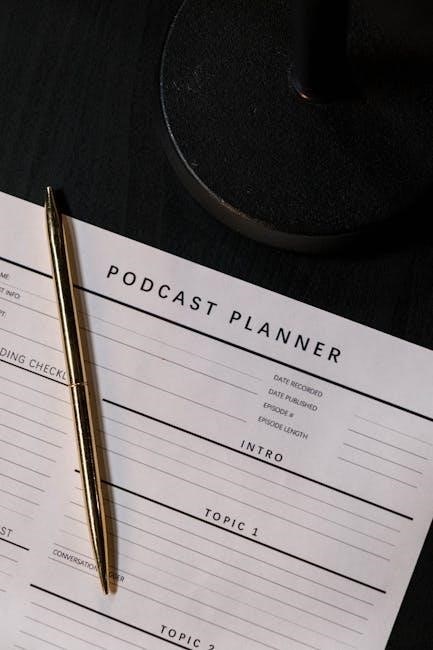Communication styles worksheets are practical tools designed to help individuals understand and improve their communication skills. These resources provide structured exercises to identify personal communication styles, fostering self-awareness and effective interaction. They are widely used in therapy, education, and professional settings to enhance interpersonal relationships and personal growth. By exploring these worksheets, users can gain insights into their communication patterns and develop strategies for more assertive and empathetic interactions. These tools are essential for anyone looking to improve their ability to convey ideas clearly and connect meaningfully with others.
1.1 What Are Communication Styles Worksheets?
Communication styles worksheets are educational tools designed to help individuals identify and understand their communication patterns. These resources, often available as downloadable PDFs, provide structured exercises and assessments to explore personal communication habits. They categorize styles into types like passive, aggressive, passive-aggressive, and assertive, offering insights into how individuals convey and receive information. By completing these worksheets, users gain self-awareness, learn effective strategies for improvement, and develop skills to enhance interpersonal interactions. They are valuable for personal growth, therapy, and professional development, guiding users to adopt healthier communication practices.
1.2 Importance of Understanding Communication Styles
Understanding communication styles is crucial for improving interpersonal relationships and personal growth. Recognizing individual tendencies helps individuals adapt their approach to different situations, fostering empathy and active listening. Effective communication reduces conflicts, enhances collaboration, and strengthens connections in both personal and professional settings. By gaining insights into communication patterns, individuals can address barriers, develop assertiveness, and cultivate a more positive and impactful interaction style, leading to better outcomes in all areas of life.

Defining Communication Styles
Communication styles refer to the ways individuals express and interpret information. They encompass verbal and non-verbal interactions, shaping how messages are conveyed and received. Understanding these styles helps identify patterns and preferences, enabling effective adaptation in various contexts. Four primary styles—passive, aggressive, passive-aggressive, and assertive—serve as a framework for analyzing and improving communication behaviors.
2.1 Overview of Communication Styles
Communication styles encompass the ways individuals convey and interpret information, influencing interactions. They include verbal and non-verbal elements, such as tone, body language, and word choice. Understanding these styles helps identify personal tendencies and adapt behaviors. Four core styles—passive, aggressive, passive-aggressive, and assertive—shape interactions. Passive styles prioritize others’ needs, while aggressive styles emphasize self-interest. Passive-aggressive styles mix avoidance and indirect expressions, whereas assertive styles balance respect and clarity. Recognizing these patterns fosters effective communication and relationship improvement.
2.2 The Four Basic Communication Styles: Passive, Aggressive, Passive-Aggressive, and Assertive
The four core communication styles are passive, aggressive, passive-aggressive, and assertive. Passive communication involves suppressing one’s needs, often leading to ineffective expression. Aggressive communication prioritizes self-interest, sometimes at others’ expense. Passive-aggressive communication combines indirectness with subtle expressions of negativity. Assertive communication, however, balances respect for oneself and others, fostering clear and constructive interactions. Understanding these styles helps individuals identify their tendencies and adapt for better communication outcomes.

Benefits of Using Communication Styles Worksheets
Communication styles worksheets enhance self-awareness, improve interpersonal skills, and provide practical tools for personal growth. They help individuals identify their communication patterns and adapt for better interactions.
3.1 Enhancing Self-Awareness and Personal Growth
Communication styles worksheets enhance self-awareness by helping individuals identify their communication patterns and understand how these impact interactions. Through structured exercises, users gain insight into their strengths and weaknesses, fostering personal growth. These tools encourage reflection on how emotions, thoughts, and behaviors influence communication, enabling individuals to develop more effective and assertive ways of expressing themselves. This self-awareness is foundational for building stronger relationships and achieving personal and professional goals.
3.2 Improving Interpersonal Relationships
Communication styles worksheets play a crucial role in improving interpersonal relationships by fostering empathy and understanding. By identifying and analyzing individual communication patterns, users can better navigate conflicts and express their needs effectively. These tools help bridge gaps in understanding, encouraging active listening and assertiveness. Improved communication leads to stronger, more meaningful connections, whether in personal or professional settings, enhancing overall relationship quality and fostering mutual respect.
3.3 Practical Applications in Therapy and Counseling
Communication styles worksheets are invaluable in therapy and counseling, offering clients tools to recognize and modify their interaction patterns. Therapists use these resources to help individuals identify passive, aggressive, or passive-aggressive tendencies, fostering assertiveness. Worksheets often include exercises for active listening, “I” statements, and boundary-setting, enabling clients to express emotions effectively. By addressing communication gaps, these tools enhance personal growth and improve relationship dynamics, making them integral to therapeutic interventions and counseling strategies.

Passive Communication Style
Passive communication involves prioritizing others’ needs over one’s own, often leading to suppressed feelings and ineffective expression. It can result in feelings of resentment and being overlooked.
4.1 Characteristics of Passive Communication
Passive communication is characterized by avoiding direct expression of feelings or needs, often prioritizing others’ concerns over one’s own. Individuals with this style tend to use indirect language, hesitate to assert themselves, and may agree excessively to maintain harmony. They often suppress emotions, leading to feelings of being undervalued or resentful. Passive communicators may avoid conflict, resulting in unmet personal needs and ineffective communication. This style can hinder personal and relational growth due to a lack of clear expression.
4.2 The Impact of Passive Communication on Relationships
Passive communication can strain relationships by creating misunderstandings and unmet expectations. Others may perceive passivity as a lack of interest or honesty, leading to frustration or emotional distance. Over time, suppressed emotions can escalate into resentment, harming trust and intimacy. Additionally, passive individuals may struggle to set boundaries, allowing others to take advantage of their accommodating nature. This dynamic can lead to an imbalance in relationships, fostering feelings of dissatisfaction for both parties involved.

Aggressive Communication Style
Aggressive communication involves dominating conversations, using harsh tones, and prioritizing one’s own needs over others. It often leads to conflicts and damaged relationships due to its confrontational nature.
5.1 Characteristics of Aggressive Communication
Aggressive communication is marked by dominant behavior, where individuals assert themselves at the expense of others. Key traits include speaking in a harsh tone, interrupting others, and using blaming or critical language. This style often involves expressing anger or frustration openly, prioritizing one’s own needs without regard for others’ feelings. It can lead to defensiveness and escalate conflicts, making it challenging to maintain healthy relationships.
5.2 The Impact of Aggressive Communication on Relationships
Aggressive communication often leads to defensiveness and hurt feelings, damaging relationships. It can create power struggles, as the focus is on winning rather than understanding others. Over time, this style fosters resentment, erodes trust, and may result in emotional distance or conflict escalation. Aggressive interactions can also discourage open dialogue, making it challenging for others to express their needs or feelings, ultimately straining personal and professional connections.
Passive-Aggressive Communication Style
Passive-aggressive communication involves expressing negative feelings indirectly through actions, not words. It includes backhanded compliments, procrastination, or sulking, often leading to confusion and unresolved conflicts in relationships.
6.1 Characteristics of Passive-Aggressive Communication
Passive-aggressive communication is marked by indirect expressions of negative emotions, often through actions rather than words. Common traits include backhanded compliments, sulking, or intentional inefficiency. This style avoids direct confrontation but conveys dissatisfaction subtly, such as through sarcasm, procrastination, or “forgetting” tasks. It can create confusion and resentment in relationships, as the true feelings remain unspoken. Over time, this indirect approach can escalate conflicts rather than resolve them, making it a challenging style to address effectively.
6.2 The Impact of Passive-Aggressive Communication on Relationships
Passive-aggressive communication often creates confusion and tension in relationships, as the indirect nature of the interactions can lead to misunderstandings and unaddressed emotions. This style may prevent open conflict but fosters resentment and frustration, as the true feelings remain unspoken. Over time, it can erode trust and intimacy, making it difficult to resolve issues effectively. Relationships may suffer from a lack of emotional honesty, leading to feelings of alienation and disconnection between individuals.

Assertive Communication Style
Assertive communication involves expressing feelings and needs clearly and respectfully, maintaining healthy boundaries while considering others. It promotes active listening, empathy, and effective interactions in personal and professional settings.
7.1 Characteristics of Assertive Communication
Assertive communication is characterized by clear, direct, and respectful expression of thoughts, feelings, and needs. It involves standing up for oneself while respecting others’ rights and boundaries. Key traits include active listening, empathy, and the use of “I” statements to avoid blame. Assertive individuals maintain eye contact, use open body language, and employ a firm yet calm tone. This style fosters mutual understanding, reduces conflict, and builds trust in relationships.
7.2 Cultivating Assertiveness for Effective Communication
Cultivating assertiveness involves practicing clear, respectful expression of needs and feelings while actively listening to others. Techniques include using “I” statements, setting boundaries, and maintaining non-verbal cues like eye contact and open body language. Regular practice, self-reflection, and feedback can enhance assertiveness, fostering confident and respectful interactions. Over time, assertiveness becomes a natural communication style, improving relationships and personal satisfaction.

Assessing Your Communication Style
Assessing your communication style involves using tools like worksheets and quizzes to identify patterns and tendencies. These resources help you recognize strengths and areas for improvement, fostering self-awareness and growth.
8.1 Tools and Assessments for Identifying Your Communication Style
Various tools and assessments, such as worksheets and quizzes, help individuals identify their communication style. These resources often include scoring guides to evaluate tendencies like passivity, aggression, or assertiveness. Reflection exercises and scenario-based questions allow users to analyze their behavior in different situations. Many assessments are customizable, catering to personal or professional contexts, and provide insights for improvement. They are widely used in therapy, education, and workplace settings to enhance communication skills and interpersonal effectiveness.
8.2 How to Score and Interpret Your Communication Style Assessment
To score your assessment, add points for each selected answer, typically ranging from 0 to 20 per style. Compare totals to identify dominant styles, such as assertive or passive-aggressive. Interpretation involves reflecting on behaviors and tendencies, helping you understand strengths and areas for improvement. This process encourages self-awareness and guides personal growth, enabling more effective communication in various contexts. Detailed instructions and examples are often provided to aid accurate interpretation and actionable insights.

The Importance of Self-Awareness in Communication
Self-awareness is crucial for effective communication, as it helps individuals understand their personal style and how others perceive them. Recognizing strengths and weaknesses fosters adaptability, leading to better interactions and relationships. This awareness is key for personal and professional growth, enabling individuals to tailor their communication strategies to various situations and audiences.
9.1 Understanding Your Personal Communication Style
Understanding your personal communication style involves recognizing how you express ideas, handle conflicts, and interact with others. Worksheets help identify whether you lean toward passive, aggressive, passive-aggressive, or assertive styles. Self-awareness is the foundation for improvement, allowing you to adapt your approach to different situations. By assessing your strengths and weaknesses, you can develop strategies to enhance clarity, empathy, and effectiveness in your interactions. This insight fosters personal growth and stronger relationships.
9.2 Adapting Your Communication Style to Different Situations
Adapting your communication style to different situations involves flexibility and awareness of the context. Worksheets help identify how to tailor your approach, ensuring clarity and empathy. Whether in personal or professional settings, understanding the needs of others allows you to adjust your style for more effective interactions. This flexibility fosters stronger connections and helps navigate conflicts. By practicing situational adaptability, you can communicate more efficiently and build meaningful relationships in diverse environments.
Adapting Communication Styles in Different Contexts
Adapting communication styles involves tailoring your approach to fit personal or professional environments, ensuring effective interactions; Worksheets help identify context-specific strategies, promoting clarity and understanding in diverse situations.
10.1 Communication Styles in Personal Relationships
Effective communication in personal relationships requires adaptability and empathy. Worksheets help identify and refine personal styles, fostering understanding and emotional connection with partners, family, and friends. By addressing passive, aggressive, or passive-aggressive tendencies, individuals can cultivate assertiveness, leading to healthier, more fulfilling relationships. These tools provide structured exercises to practice active listening, express emotions clearly, and resolve conflicts constructively, strengthening bonds and improving overall communication dynamics in personal interactions and daily exchanges.
10.2 Communication Styles in Professional Settings
In professional environments, understanding communication styles is crucial for collaboration and productivity. Worksheets help employees identify their tendencies, such as passive, aggressive, or assertive styles, and adapt them to workplace demands. By fostering clarity, active listening, and conflict resolution, these tools enhance teamwork and leadership. They also promote a culture of respect and efficiency, enabling professionals to communicate effectively with colleagues, clients, and supervisors, ensuring alignment and success in organizational goals and projects.
Practical Steps for Using Communication Styles Worksheets
Start by identifying your communication style, reflect on past interactions, practice assertiveness techniques, and seek feedback to enhance your skills effectively.
11.1 Step-by-Step Guide to Completing the Worksheet
Begin by identifying your primary communication style using the assessment tool. Reflect on past interactions to recognize patterns. Complete the worksheet exercises, such as identifying passive, aggressive, or assertive behaviors. Practice active listening and empathy techniques. Review and apply feedback to improve your communication skills. Use the worksheet to develop a plan for adapting your style in different contexts, fostering personal and professional growth through effective interaction.
11.2 Case Examples of Effective Communication Style Assessments
Case examples demonstrate how individuals successfully assessed their communication styles using worksheets. For instance, one client recognized their passive tendencies and learned to express needs assertively, improving workplace interactions. Another shifted from aggressive to assertive communication, enhancing personal relationships. These examples highlight practical applications, showing how structured exercises and self-reflection lead to meaningful behavioral changes and stronger connections with others.
Overcoming Barriers to Effective Communication
Overcoming barriers to effective communication involves addressing emotional challenges, fostering active listening, and practicing empathy to enhance understanding and connection in personal and professional interactions.
12.1 Common Barriers to Effective Communication
Common barriers to effective communication include stress, uncontrolled emotions, and language differences. Non-verbal cues, distractions, and physical environments can also hinder clarity. Additionally, cultural differences, technological issues, and preconceived biases often obstruct clear message transmission. These barriers can lead to misunderstandings, conflict, and strained relationships, emphasizing the need to address and overcome them for successful interactions in both personal and professional settings.
12.2 Strategies for Overcoming Communication Barriers
Strategies for overcoming communication barriers include active listening, practicing empathy, and using “I” statements. Clarifying expectations and adapting communication styles to the audience can enhance understanding. Non-verbal cues like eye contact and open body language also improve interactions. Regular feedback and addressing conflicts promptly help maintain clear communication. These strategies foster effective dialogue, reducing misunderstandings and strengthening relationships in both personal and professional contexts.

The Role of Empathy and Active Listening in Communication
Empathy and active listening are cornerstone communication skills, fostering deeper understanding and stronger connections. They involve fully engaging with others, acknowledging their perspectives, and responding thoughtfully.
13.1 The Importance of Empathy in Communication
Empathy plays a vital role in communication by allowing individuals to understand and share the feelings of others. It fosters trust and connection, making interactions more meaningful. By acknowledging others’ emotions, empathy helps resolve conflicts and strengthens relationships. In therapeutic settings, empathy aids clients in feeling heard and validated. Worksheets designed to enhance empathy guide users in recognizing and responding to emotional cues, promoting a deeper understanding of others’ perspectives and experiences.
13.2 Techniques for Active Listening
Active listening is a cornerstone of effective communication, requiring full attention and engagement with the speaker. Techniques include maintaining eye contact, nodding, and using verbal cues like “I see” to show understanding. Paraphrasing and summarizing the speaker’s message ensures clarity and demonstrates empathy. Worksheets often include exercises to practice these skills, such as reflecting statements or identifying emotions, helping individuals refine their ability to listen actively and respond thoughtfully in various contexts.

Advanced Techniques for Effective Communication
Advanced techniques for effective communication include using “I” statements to express feelings without blame and employing non-verbal cues like body language and eye contact to enhance interactions.
14.1 Using “I” Statements for Assertive Communication
Using “I” statements is a powerful technique for assertive communication, allowing individuals to express feelings and needs without blaming others. This approach fosters mutual respect and reduces defensiveness. For example, saying “I feel overwhelmed when tasks are not shared” instead of “You never help,” promotes constructive dialogue. Worksheets often include exercises to practice crafting “I” statements, helping users communicate more effectively and maintain healthy relationships. This skill is essential for conflict resolution and personal growth.
14.2 The Role of Non-Verbal Communication in Interactions
Non-verbal communication, such as body language, facial expressions, and eye contact, plays a crucial role in interactions by conveying emotions and intentions. These cues often carry more weight than spoken words, influencing how messages are perceived. Worksheets on communication styles emphasize the importance of aligning non-verbal signals with verbal messages to avoid misunderstandings. By practicing awareness of gestures, tone, and posture, individuals can enhance their ability to communicate effectively and build stronger connections with others.
Understanding and refining communication styles through worksheets fosters personal growth, enhances relationships, and improves overall interaction effectiveness. Consistent practice and self-awareness are key to mastering these skills and achieving meaningful connections.
15.1 Summary of Key Takeaways
Effective communication is rooted in understanding personal styles and adapting to situations. Worksheets help identify passive, aggressive, passive-aggressive, and assertive tendencies, fostering self-awareness. They enable individuals to enhance interpersonal relationships, resolve conflicts, and improve professional interactions. By practicing active listening, using “I” statements, and embracing empathy, individuals can cultivate assertiveness and overcome communication barriers. These tools empower personal growth, strengthen connections, and promote meaningful exchanges in all aspects of life.
15.2 Encouragement to Practice and Improve Communication Skills
Consistent practice is key to mastering effective communication. Use worksheets to identify your style and refine your approach. Regularly applying these tools fosters self-awareness, helping you navigate relationships and professional interactions with confidence. Embrace opportunities to adapt your style, practice active listening, and express yourself assertively. The more you engage with these exercises, the more naturally effective communication will become, leading to stronger connections and personal growth.




